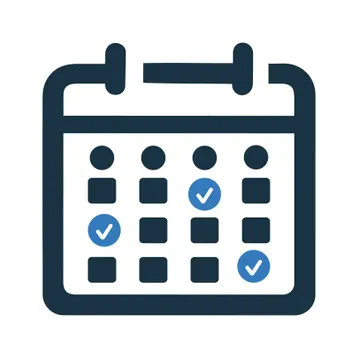
Developing an effective employee onboarding program is a critical component of a company's talent acquisition efforts. After all, new employees should feel confident that they accepted the right offer from the very first day. The onboarding phase of an employee's tenure at an organization sets the tone for their performance and expectations. An ill-planned experience can be demotivating and may even be the catalyst for deciding the job's not for them. HR can prevent a new hire's dissatisfaction with the onboarding experience by planning each step of the process thoughtfully. One of the main things to decide is how long the onboarding process will take. From there, building an onboarding timeline is essential.
Why is an employee onboarding timeline important?
The adage, "If you fail to plan, then you plan to fail" rings true for an onboarding plan. If HR doesn't provide a schedule and necessary materials and participants, chances are something will fall through the cracks. An onboarding timeline helps the person responsible for the onboarding process keep it on track. It also clearly communicates the roles other participants play. Finally, it shows a new employee that the company is well-run and they're a valuable addition to the workforce.
Factors that play into the length of your onboarding process
Each employee onboarding process is different, depending on certain factors. Three determinants of the onboarding timeline are:
Company size and industry
A small company with fewer employees and 1 location may require a shorter onboarding timeline than its larger, more complex counterparts’. Likewise, those within highly complicated industries may require more time than others for the new hire onboarding process.
Role or position
An employee's journey varies greatly depending on the role they're filling for the company. High-level positions with numerous job responsibilities demand a far more intense onboarding process than do roles with simpler expectations.
On-site vs. remote employees
Remote onboarding tends to be more challenging than on-site onboarding. While video conferences give HR professionals and hiring managers access to remote employees, it's still harder to stay engaged. With on-site onboarding, the new hire can benefit from a quick, unplanned check in and one-off conversations on the spot. Those aren't possible for their remote counterparts. Therefore, remote onboarding may take longer to complete.
How to lay out an onboarding timeline
It's wise to create a complete onboarding timeline well before a new employee's start date. Proactive planning offers ample time to schedule everything effectively. Here's a basic outline you can tailor and then put into action:
Preboarding: 1-3 days
Onboarding programs may or may not include pre-onboarding. This takes place before the employee's first day. Preboarding may include completing some new hire paperwork and reviewing the employee handbook and other important role-related policies.
Employee orientation: 1 day to 1 week
Upon the employee's arrival, the orientation is the welcome the new hire receives. It's the "warm and fuzzy" part of a successful onboarding process. Orientation activities can include conversing with coworkers, introductions to the work environment, and receiving necessities like laptop and parking pass. The
employee orientation phase is immensely important, as it gives the new hire their first taste of the company culture.
Candidate to new hire transition: 1-2 days
Following the fun, social orientation time, this part of the onboarding timeline gets down to business. New hires meet with HR or those in charge of their
onboarding process. They complete remaining necessary paperwork, start learning about the company's mission and core values, and may have lots of questions. Many see this as the breather before the real work begins.
Expectation and goal setting: 1-2 days
Typically by now, the new employee has completed their first week and gained some footing. Now it's time to dig into the meat of the role and talk about the employee's performance expectations. These may be daily, monthly, or quarterly goals required of the position. Setting expectations helps the new hire get a broad view of how they will contribute to the organization over time.
Job training: 1 week to 2 months
Based upon what the new employee is expected to do, it's time to begin teaching them how to do it. Job training includes the company-specific tasks required of the employee. Exact responsibilities often stem from previous work history, education, and experience. The new hire will learn about their team and manager and start soaking in how the company functions. The length of this stage of the onboarding timeline depends largely upon the social and performance aspects of the role.
New hire transition: 60-90 days
Once trained, new employees start performing their duties and handling the responsibilities of their new job. There will be extra oversight from their manager during this period, along with frequent feedback about the employee's performance. Feedback may be solicited from multiple sources, including new employees, their coworkers, managers, and perhaps even select customers or clients. Collection methods can include an onboarding survey, frequent check-ins, video chats, and real-time workplace conversations. Creating an onboarding timeline is vital to executing a successful onboarding process. Keep in mind they are flexible depending on your company's needs and the role being filled. Taking time to build a cohesive program will likely result in stronger employee performance, streamlined workflow, and greater employee retention. Get help building your own timeline with our free, complete guide on employee onboarding.
For ongoing tips, tools, and other resources for HR and business management, visit TriNet.com/Insights
This communication is for informational purposes only; it is not legal, tax or accounting advice; and is not an offer to sell, buy or procure insurance.
This post may contain hyperlinks to websites operated by parties other than TriNet. Such hyperlinks are provided for reference only. TriNet does not control such web sites and is not responsible for their content. Inclusion of such hyperlinks on TriNet.com does not necessarily imply any endorsement of the material on such websites or association with their operators.





